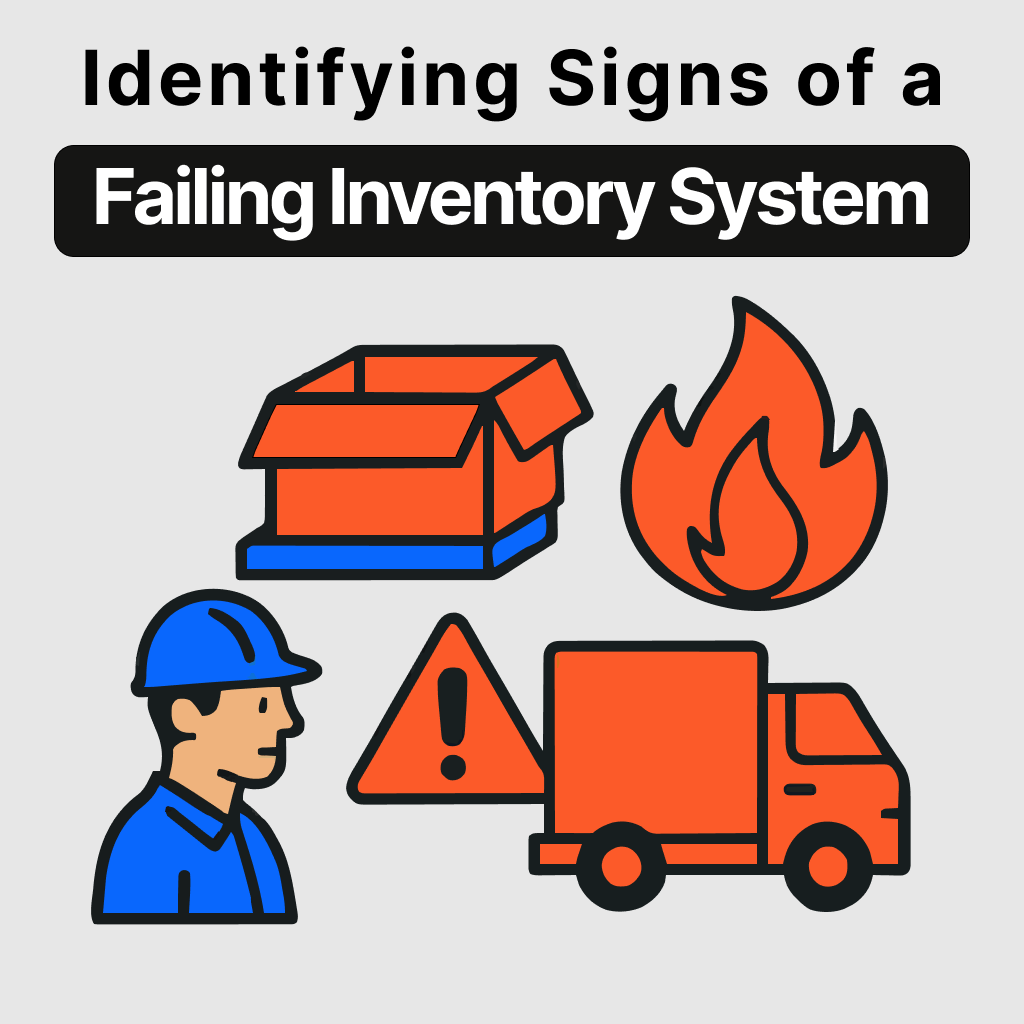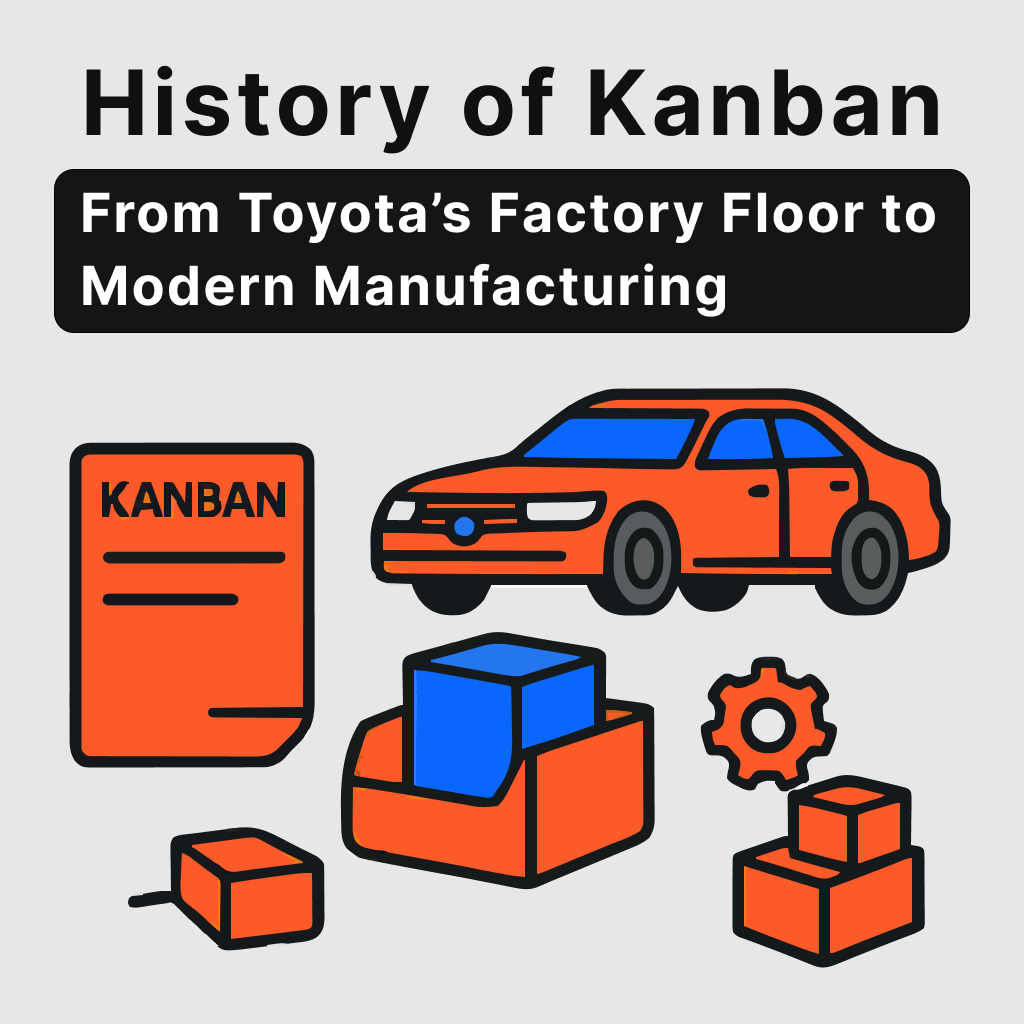How many times last quarter did a production run stop because a critical component was missing? How much did you spend on expedited shipping just to keep operations moving? If the answers are "more than I'd like" or "I'm not even sure," it’s a clear sign that hidden inefficiencies in your inventory system are eating into your profits.
For many businesses, this constant firefighting feels normal, but it’s a costly symptom of a dysfunctional inventory system. Each stockout, each manual count, and each delayed order is a data point telling you that your current process is no longer serving your business. The first step to fixing the problem is learning to see these daily headaches for what they truly are: critical warnings.
This guide will help you identify the 10 telltale signs of poor inventory control that are holding you back and show you the path toward operational excellence.
Understanding the Hidden Cost of Inventory System Failure
Before diving into the specific warning signs, it's important to understand what's at stake. The global retail and manufacturing industry incurs $1.75 trillion annually in losses from out-of-stock events alone, representing about 8.3% of total sales. For manufacturers, inventory system failure doesn't just cause occasional inconveniences – it creates a ripple effect that touches every aspect of your operation.
On average, the inventory carrying costs for manufacturers are 10-20% and can be as high as 30-40% for inefficiently managed inventory. So for a manufacturer holding $1 million worth of excess inventory, the annual costs of warehousing, taxes, material handling and interest can be as high as $400,000. This excess represents capital that could be deployed elsewhere in your business while you simultaneously struggle with stockouts of critical components.
The manufacturers who thrive are those who recognize these signs early and take decisive action to improve your inventory management system. They understand that modern inventory management isn't just about knowing what's on the shelf – it's about creating a foundation for strategic decision-making and sustainable growth.
The 10 Critical Warning Signs of Inventory System Failure
1. Constant Stockouts and Production Delays
One of the most obvious signs of a failing inventory system is when you frequently cannot find the materials you need, when you need them. This directly halts production and leaves your teams waiting for essential components to arrive.
- Production Stoppages: Operations are regularly interrupted because necessary raw materials or components are unavailable, despite what the system indicates.
- Delayed Orders: This inability to produce goods on schedule directly leads to postponed customer shipments.
- Eroding Trust: Consistently failing to meet deadlines damages your reputation and causes customers to question your reliability.
- Lost Revenue: Every delayed or canceled order due to stockouts is a direct hit to your bottom line and can lead to permanent customer loss.
Takeaway: Frequent stockouts are a clear signal that your system cannot accurately anticipate demand, leading to production failures and disappointed customers.
2. Excess and Obsolete Inventory Accumulation
The opposite of a stockout is just as damaging. When capital is tied up in products that aren't selling, it creates a significant financial drain and operational burden on your business.
- Tied-Up Capital: Money is trapped in unsold goods, preventing you from investing in growth, innovation, or other critical business areas.
- Increased Holding Costs: Storing excess inventory costs money through warehousing, insurance, and handling fees.
- Wasted Space: Obsolete items take up valuable warehouse real estate that could be used for popular, fast-moving products.
- Risk of Obsolescence: The longer an item sits on the shelf, the higher the chance it will become outdated, damaged, or unusable, eventually turning into a complete loss.
Takeaway: A growing pile of excess and obsolete stock points to flawed forecasting and a lack of visibility into which products are actually generating revenue.
3. Inaccurate Inventory Records and Data Discrepancies
If your team cannot trust the data in your inventory system, its value is immediately undermined. When the numbers on the screen don't match the physical count on the shelves, every decision becomes a gamble.
- Lack of Confidence: Discrepancies between digital records and physical stock destroy trust in the system for everyone, from the warehouse floor to the sales team.
- Flawed Decision-Making: Inaccurate data leads to poor purchasing choices, incorrect production planning, and unreliable financial reporting.
- Unreliable Commitments: It becomes impossible to confidently promise delivery dates to customers when you aren't sure what you actually have in stock.
- Common Causes: These issues often stem from manual data entry errors, unreported damages, theft, or a lack of standardized receiving and shipping processes.
Takeaway: Persistent inaccuracies in your inventory data make strategic planning impossible and indicate that your tracking processes are fundamentally broken.
4. Heavy Reliance on Manual Processes and Spreadsheets
Using spreadsheets or paper-based ledgers to manage inventory is inefficient and cannot keep up with the complexities of a growing business. These manual methods are a bottleneck that stifles growth and invites errors.
- Prone to Human Error: Manual data entry is highly susceptible to mistakes that can have a ripple effect across your entire operation.
- Time-Consuming: Your team spends countless hours on administrative data entry instead of focusing on more strategic, value-adding activities.
- Lack of Real-Time Data: Spreadsheets are always outdated. They can't provide the instant, up-to-the-minute information needed to make agile business decisions.
- Difficult to Scale: As your business grows in complexity, a manual system quickly becomes overwhelmed and unmanageable.
Takeaway: Over-reliance on manual processes is a major operational inefficiency that limits your ability to respond quickly to market changes and scale effectively.
5. Lack of Real-Time Inventory Visibility
In today's fast-paced market, decisions must be made with current information. If you can't see exactly what inventory you have and where it is at any given moment, you are operating at a significant disadvantage.
- Informed Decision-Making is Impossible: Without real-time data, you are always reacting to old information, leading to poor choices.
- Difficulty Managing Multiple Locations: It's especially challenging to manage stock effectively across several warehouses or facilities without a centralized, live view.
- Inaccurate Customer Updates: Sales and service teams are left in the dark, unable to give customers reliable information about product availability or order status.
- Inefficient Operations: A lack of visibility leads to wasted time as employees must manually verify stock levels before making commitments.
Takeaway: If you don't have instant visibility into your entire inventory, you're operating blind and cannot make the quick, strategic decisions necessary to stay competitive.
6. Inaccurate Demand Forecasting and Planning Failures
When you consistently over- or underestimate how much product you'll need, it's a sign that your forecasting methods are failing. This core problem is often the root cause of both stockouts and excess inventory.
- Creates a Vicious Cycle: Poor forecasting directly leads to the twin problems of having too much of what you don't need and not enough of what you do.
- Missed Sales Opportunities: Underestimating demand means you run out of popular items, leaving potential sales on the table for competitors to grab.
- Forced Markdowns: Overestimating demand results in a surplus of products that must be sold at a steep discount, hurting your profit margins.
- Production Instability: Inaccurate forecasts make it impossible to plan production schedules efficiently, leading to constant adjustments and disruptions.
Takeaway: Faulty demand forecasting is a fundamental failure that guarantees you will always have the wrong amount of inventory, creating a cascade of costly problems.
7. Frequent Emergency Physical Inventory Counts
Having to stop operations for an unplanned, "all-hands-on-deck" physical count is a clear distress signal. It indicates that no one trusts the system's data, forcing you to resort to disruptive manual checks.
- Disrupts Operations: These emergency counts pull employees away from their primary duties, halting productivity across multiple departments.
- Wastes Labor Hours: The time and money spent on frequent manual counting is a significant operational expense that produces no value.
- Highlights Lack of Trust: It is a public admission that your inventory system is unreliable and cannot be used for day-to-day decisions.
- Reactive Management: This behavior keeps your team stuck in a reactive "firefighting" mode, preventing any opportunity for proactive, strategic improvement.
Takeaway: If you're constantly performing emergency counts, your system has already failed; it shows a complete breakdown of trust in your inventory data.
8. Increased Expediting and Rush Orders
A constant state of crisis where you are paying premium fees for rush orders and expedited shipping is unsustainable. This is a symptom of poor forward-planning and a breakdown in supply chain management.
- Increased Costs: Expediting fees and premium shipping costs directly eat into your profit margins on every order.
- Strained Supplier Relationships: Constantly making urgent demands can damage your relationships with suppliers, potentially leading to lower service levels in the future.
- Stressful Work Environment: Operating in a perpetual state of emergency creates stress for your employees and leads to burnout.
- Indication of Poor Planning: It shows that your system is not anticipating needs ahead of time, forcing you to react at the last minute.
Takeaway: A consistent need for rush orders means your inventory planning is purely reactive, costing you more money and creating unnecessary stress.
9. Rising Inventory Carrying Costs
The expenses associated with holding inventory, such as storage, insurance, and labor, can be a silent drain on profitability. If these costs are steadily climbing, it's a sign your inventory levels are inefficient and poorly managed.
- Key Carrying Costs Include:
- Warehouse rent and utilities
- Insurance and taxes on held goods
- Labor for moving and managing stock
- Losses from damage, spoilage, or theft
- Tied-Up Capital: Beyond direct costs, this includes the opportunity cost of having money invested in inventory instead of elsewhere in the business.
- Signs of Inefficiency: Rising costs often point to holding too much safety stock, failing to get rid of obsolete items, or using warehouse space poorly.
Takeaway: Increasing carrying costs are a financial warning that you are holding onto too much non-productive inventory for too long.
10. Declining Customer Satisfaction and Service Issues
Ultimately, the most critical sign of a failing inventory system is when your customers start to notice. Issues like late shipments, incorrect orders, and frequent backorders are direct consequences of poor inventory control that can cause long-term damage to your brand.
- Common Customer Complaints:
- Items being unavailable or on backorder.
- Shipments arriving later than promised.
- Receiving the wrong products or quantities.
- Erosion of Brand Reputation: Each service failure chips away at customer trust and your reputation for reliability.
- Loss of Repeat Business: Unhappy customers are unlikely to return, and they may share their negative experiences with others.
- Competitive Disadvantage: As your service levels drop, you become less competitive compared to rivals who can deliver more consistently.
Takeaway: When inventory problems start to impact the customer experience, it's no longer just an internal issue, it's a direct threat to your company's survival.
%201.svg)








.svg)














.svg)
.svg)

.svg)